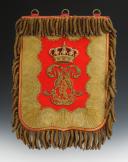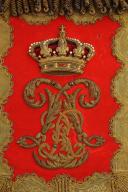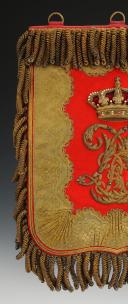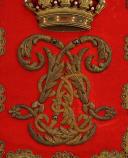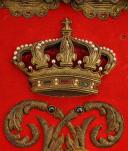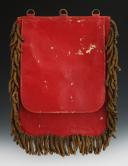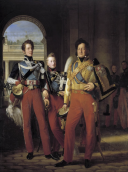
SABRETACHE IN GRAND ATTIRE OF COLONEL GENERAL OF THE HUSSARDS WHICH BELONGED TO LOUIS PHILIPPE DUC D’ORLÉANS (future King), Restoration. 27479
Sold out
SABRETACHE IN GRAND ATTIRE OF COLONEL GENERAL OF THE HUSSARDS WHICH BELONGED TO LOUIS PHILIPPE DUC D’ORLÉANS (future King), Restoration. 27479
In scarlet patent leather. Clutch bag lined with orange velvet, H 28.5 cm, width at the top 24.5 cm, width at the bottom 25 cm, it closes with a buttonhole flap and a scarlet waxed woven leather button.
Tab covered with scarlet cloth richly embroidered in threads, cannetilles, sequins, pearls and lamé with intertwined “L R” number and under royal crown with pearly pearls and green and scarlet lamé with burgundy velvet background, bordered with a large braid in golden trimmings of the species called "general's edge", woven from a double oak branch with its fruits with scalloped, crested edges, minimum width of the braid 4 cm and 6 cm maximum. On its outer edge, the tab is embroidered with a 3 mm wide net of gold threads and sequins. The sabretache is trimmed all around with fringes of coarse gold trimmings, called “spinach seeds”, 6 cm long. It is complete with its three semi-circular suspension rings. H 35 cm, width at the top 27.5 cm, width at the bottom 27.5 cm.
France.
Restoration.
Very good condition, two moth holes on the sheet covering the tab, leather linings of the tab and the pouch with worm holes.
ORIGIN :
Estate of Monseigneur Prince Henri d'Orléans, Count of Paris, Paris Drouot, October 30, 2000, lot 178.
HISTORY:
Article 5 of the order of May 15, 1814, on the appointment of colonels general decided that the King's cousin, the Duke of Orléans, became Colonel General of the Hussars. We only see this superb sabretache from behind, notably in the painting by Baron Gérard representing the Duke of Orléans in the uniform of colonel general of the hussars (1817). This sabretache takes up the motif of the sabretaches of the old regime (found on the sabretaches of the Bercheny regiment) with the number of the sovereign (the two opposite Ls) and the letter "R" (like "Rex", or King ). This figure was that of King Louis XVI and will be taken up by King Louis XVIII.
LOUIS-PHILIPPE :
Louis-Philippe I, or simply Louis-Philippe, born October 6, 1773 in Paris (France) and died August 26, 1850 in Claremont House, Surrey (United Kingdom), is the last king to have reigned in France, between 1830 and 1848, with the title of “king of the French”. Much less traditionalist than his predecessors, he embodied a major turning point in the conception and image of royalty in France.
First prince of the blood under the Restoration (because he is a descendant of Louis XIII), Prince Louis-Philippe, during his life, successively held the titles of Duke of Valois (1773-1785), Duke of Chartres (1785-1790) and finally that of Duke of Orléans (1793-1830) before acceding to the crown in 1830, his cousin Charles
Eighteen years at the head of a kingdom undergoing profound social, economic and political changes, Louis-Philippe – through the July Monarchy – attempted to pacify a deeply divided Nation with the weapons of his time: establishment of a parliamentary regime, accession of the bourgeoisie to manufacturing and financial affairs, allowing economic growth of major importance in France (industrial revolution).
Louis-Philippe wanted to be a “citizen king” listening to the real country, called to the throne and linked to the country by a contract from which he wanted to draw legitimacy. However, it did not respond to the desire to expand the electorate, for the most conservative by lowering the census, for the most progressive by establishing universal suffrage.
In scarlet patent leather. Clutch bag lined with orange velvet, H 28.5 cm, width at the top 24.5 cm, width at the bottom 25 cm, it closes with a buttonhole flap and a scarlet waxed woven leather button.
Tab covered with scarlet cloth richly embroidered in threads, cannetilles, sequins, pearls and lamé with intertwined “L R” number and under royal crown with pearly pearls and green and scarlet lamé with burgundy velvet background, bordered with a large braid in golden trimmings of the species called "general's edge", woven from a double oak branch with its fruits with scalloped, crested edges, minimum width of the braid 4 cm and 6 cm maximum. On its outer edge, the tab is embroidered with a 3 mm wide net of gold threads and sequins. The sabretache is trimmed all around with fringes of coarse gold trimmings, called “spinach seeds”, 6 cm long. It is complete with its three semi-circular suspension rings. H 35 cm, width at the top 27.5 cm, width at the bottom 27.5 cm.
France.
Restoration.
Very good condition, two moth holes on the sheet covering the tab, leather linings of the tab and the pouch with worm holes.
ORIGIN :
Estate of Monseigneur Prince Henri d'Orléans, Count of Paris, Paris Drouot, October 30, 2000, lot 178.
HISTORY:
Article 5 of the order of May 15, 1814, on the appointment of colonels general decided that the King's cousin, the Duke of Orléans, became Colonel General of the Hussars. We only see this superb sabretache from behind, notably in the painting by Baron Gérard representing the Duke of Orléans in the uniform of colonel general of the hussars (1817). This sabretache takes up the motif of the sabretaches of the old regime (found on the sabretaches of the Bercheny regiment) with the number of the sovereign (the two opposite Ls) and the letter "R" (like "Rex", or King ). This figure was that of King Louis XVI and will be taken up by King Louis XVIII.
LOUIS-PHILIPPE :
Louis-Philippe I, or simply Louis-Philippe, born October 6, 1773 in Paris (France) and died August 26, 1850 in Claremont House, Surrey (United Kingdom), is the last king to have reigned in France, between 1830 and 1848, with the title of “king of the French”. Much less traditionalist than his predecessors, he embodied a major turning point in the conception and image of royalty in France.
First prince of the blood under the Restoration (because he is a descendant of Louis XIII), Prince Louis-Philippe, during his life, successively held the titles of Duke of Valois (1773-1785), Duke of Chartres (1785-1790) and finally that of Duke of Orléans (1793-1830) before acceding to the crown in 1830, his cousin Charles
Eighteen years at the head of a kingdom undergoing profound social, economic and political changes, Louis-Philippe – through the July Monarchy – attempted to pacify a deeply divided Nation with the weapons of his time: establishment of a parliamentary regime, accession of the bourgeoisie to manufacturing and financial affairs, allowing economic growth of major importance in France (industrial revolution).
Louis-Philippe wanted to be a “citizen king” listening to the real country, called to the throne and linked to the country by a contract from which he wanted to draw legitimacy. However, it did not respond to the desire to expand the electorate, for the most conservative by lowering the census, for the most progressive by establishing universal suffrage.
Reference :
27479
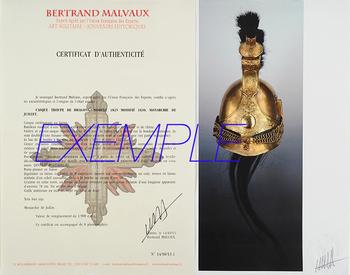
Next update Friday, december 26 at 13:30 PM
FOR ALL PURCHASES, PAYMENT IN MULTIPLE CHECKS POSSIBLE
bertrand.malvaux@wanadoo.fr 06 07 75 74 63
SHIPPING COSTS
Shipping costs are calculated only once per order for one or more items, all shipments are sent via registered mail, as this is the only way to have proof of dispatch and receipt.
For parcels whose value cannot be insured by the Post, shipments are entrusted to DHL or Fedex with real value insured, the service is of high quality but the cost is higher.
RETURN POLICY
Items can be returned within 8 days of receipt. They must be returned by registered mail at the sender's expense, in their original packaging, and in their original condition.
AUTHENTICITY
The selection of items offered on this site allows me to guarantee the authenticity of each piece described here, all items offered are guaranteed to be period and authentic, unless otherwise noted or restricted in the description.
An authenticity certificate of the item including the description published on the site, the period, the sale price, accompanied by one or more color photographs is automatically provided for any item priced over 130 euros. Below this price, each certificate is charged 5 euros.
Only items sold by me are subject to an authenticity certificate, I do not provide any expert reports for items sold by third parties (colleagues or collectors).
FOR ALL PURCHASES, PAYMENT IN MULTIPLE CHECKS POSSIBLE
bertrand.malvaux@wanadoo.fr 06 07 75 74 63
An authenticity certificate of the item including the description published on the site, the period, the sale price, accompanied by one or more color photographs is automatically provided for any item priced over 130 euros. Below this price, each certificate is charged 5 euros.
Only items sold by me are subject to an authenticity certificate, I do not provide any expert reports for items sold by third parties (colleagues or collectors).
